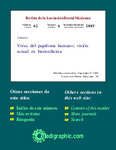
Please use this identifier to cite or link to this item:
http://ricaxcan.uaz.edu.mx/jspui/handle/20.500.11845/862Full metadata record
| DC Field | Value | Language |
|---|---|---|
| dc.contributor | 121534 | es_ES |
| dc.contributor.other | https://orcid.org/0000-0002-1513-4971 | - |
| dc.contributor.other | 0000-0002-1513-4971 | - |
| dc.coverage.spatial | Global | es_ES |
| dc.creator | Premoli, Gloria | - |
| dc.creator | González, Ana julia | - |
| dc.creator | Villarreal, Juana | - |
| dc.creator | Percoco, Tiziana | - |
| dc.creator | Pietrocino, Pierina | - |
| dc.creator | Aguilera Galaviz, Luis Alejandro | - |
| dc.date.accessioned | 2019-03-26T16:59:38Z | - |
| dc.date.available | 2019-03-26T16:59:38Z | - |
| dc.date.issued | 2005-11 | - |
| dc.identifier | info:eu-repo/semantics/publishedVersion | es_ES |
| dc.identifier.issn | 0001-0944 | es_ES |
| dc.identifier.uri | http://localhost/xmlui/handle/20.500.11845/862 | - |
| dc.identifier.uri | https://doi.org/10.48779/08q2-hd74 | - |
| dc.description | Human papillomaviruses (HPV) are epitheliotropic and double-stranded DNA viruses, which produce verrucous lesions in mucoses and skin. There are more than 100 types, and some of them have an oncogenic potential which depends of its capacity of transformation and integra- tion into the host cell. HPV are strongly associated with cervical and other kind of cancer. Even though the traditional diagnostic methods like Papanicolaou cytology (Pap) continues being a valuable tool for the tamizaje of the injuries produced by the VPH, in the last decades they have been used molecular techniques like the polymerase chain reaction, Hibridization in situ, capture of hybrids among others; which are more effective in the detection of the infection has helped in the screening of HPV however, moleculars techniques such as polymerase chain reaction and hybrids capture has been used in the last years showing better diagnostic effi- ciency. The main purpose of this review is to give an update of HPV which will help to have a better understanding of the virus, its pathological and epidemiological behavior, and the latest in technology for its diagnostic and prevention. | es_ES |
| dc.description.abstract | Los papilomavirus humanos (VPH) son virus epiteliotrópicos de doble cadena de ADN que producen lesiones verrugosas en piel y mucosas. Actualmente se conocen más de 100 tipos, de los cuales algunos de ellos tienen potencial oncogénico variable dependiendo de la capa- cidad de transformación e integración en la célula hospedadora y están fuertemente asocia- dos con cáncer cervical así como otros tipos de cáncer. Aun cuando los métodos tradiciona- les como la técnica de Papanicolaou sigue siendo una herramienta valiosa para el tamizaje de las lesiones producidas por el VPH, en las últimas décadas se han usado técnicas molecu- lares como la reacción en cadena de la polimerasa, Hibridización in situ, captura de híbridos entre otras; las cuales son más efectivas en cuanto a la detección de la infección. El objetivo de esta revisión es proporcionar información amplia y actualizada sobre el VPH que permitirá el mejor entendimiento del virus, su comportamiento patológico, epidemiológico, nuevos en- foques de diagnóstico y recientes avances en el área preventiva. | es_ES |
| dc.language.iso | spa | es_ES |
| dc.publisher | Asociación Dental Mexicana | es_ES |
| dc.relation.uri | generalPublic | es_ES |
| dc.rights | Atribución-NoComercial-CompartirIgual 3.0 Estados Unidos de América | * |
| dc.rights.uri | http://creativecommons.org/licenses/by-nc-sa/3.0/us/ | * |
| dc.source | Revista ADM 2005;Vol. LXII, No. 6, pp. 213-224 | es_ES |
| dc.subject.classification | MEDICINA Y CIENCIAS DE LA SALUD [3] | es_ES |
| dc.subject.other | VPH | es_ES |
| dc.subject.other | neoplasias | es_ES |
| dc.subject.other | virus papiloma humano | es_ES |
| dc.subject.other | morfología | es_ES |
| dc.subject.other | diagnóstico | es_ES |
| dc.subject.other | herramientas moleculares | es_ES |
| dc.subject.other | vacunas | es_ES |
| dc.subject.other | human papilloma virus | es_ES |
| dc.subject.other | morphology | es_ES |
| dc.subject.other | diagnostic | es_ES |
| dc.subject.other | molecular tools | es_ES |
| dc.subject.other | vaccines | es_ES |
| dc.title | Virus del papiloma humano; visión actual en biomedicina | es_ES |
| dc.type | info:eu-repo/semantics/article | es_ES |
| Appears in Collections: | *Documentos Académicos*-- UA Odontología | |
Files in This Item:
| File | Description | Size | Format | |
|---|---|---|---|---|
| Virus del papiloma humano.pdf | 179,52 kB | Adobe PDF |  View/Open |
This item is licensed under a Creative Commons License
